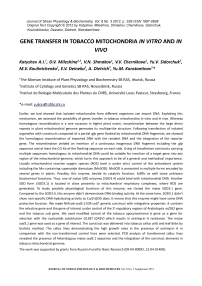Gene transfer in tobacco mitochondria in vitro and in vivo
Автор: Katyshev A.I., Mileshina D.V., Shmakov V.N., Chernikova V.V., Sidorchuk Yu.V., Koulintchenko M.V., Deineko E.V., Dietrich A., Konstantinov Yu.M.
Журнал: Журнал стресс-физиологии и биохимии @jspb
Рубрика: Supplement
Статья в выпуске: 3 т.8, 2012 года.
Бесплатный доступ
Mitochondria, import dna, in vitro, mnsod, reactive oxygen species, arabidopsis, construct, genome
Короткий адрес: https://sciup.org/14323643
IDR: 14323643
Текст статьи Gene transfer in tobacco mitochondria in vitro and in vivo
Journal of Stress Physiology & Biochemistry, Vol. 8 No. 3 2012, p. S26 ISSN 1997-0838 Original Text Copyright © 2012 by Katyshev, Mileshina, Shmakov, Chernikova, Sidorchuk, Koulintchenko, Deineko, Dietrich, Konstantinov
GENE TRANSFER IN TOBACCO MITOCHONDRIA IN VITRO AND IN VIVO
-
1The Siberian Institute of Plant Physiology and Biochemistry SB RAS, Irkutsk, Russia
-
2Institute of Cytology and Genetics SB RAS, Novosibirsk, Russia
-
3Institut de Biologie Moléculaire des Plantes du CNRS, Université Louis Pasteur, Strasbourg, France
Earlier, we had showed that isolated mitochondria from different organisms can import DNA. Exploiting this mechanism, we assessed the possibility of genes transfer in tobacco mitochondria in vitro and in vivo . Whereas homologous recombination is a rare occasion in higher plant nuclei, recombination between the large direct repeats in plant mitochondrial genome generates its multipartite structure. Following transfection of isolated organelles with constructs composed of a partial gfp gene flanked by mitochondrial DNA fragments, we showed the homologous recombination of imported DNA with the resident DNA and the integration of the reporter gene. The recombination yielded an insertion of a continuous exogenous DNA fragment including the gfp sequence and at least the 0.5 kb of the flanking sequence on each side. Using of transfection constructs carrying multiple sequences homologous to mitochondrial DNA could be suitable for insertion of a target gene into any region of the mitochondrial genome, which turns this approach to be of a general and methodical importance. Usually mitochondrial reactive oxygen species (ROS) level is under strict control of the antioxidant system including the Mn-containing superoxide dismutase (MnSOD). MnSOD is presented in multiple forms encoded by several genes in plants. Possibly, this enzyme, beside its catalytic function, fulfills as well some unknown biochemical functions. Thus, one of maize SOD enzymes (SOD3.4) could bind with mitochondrial DNA. Another SOD form (SOD3.1) is located in close proximity to mitochondrial respiratory complexes, where ROS are generated. To study possible physiological functions of this enzyme, we cloned the maize SOD3.1 gene. Compared to the SOD3.4, this enzyme didn't demonstrate DNA-binding activity. At the same time, SOD3.1 didn't show non-specific DNA-hydrolyzing activity as Cu/ZnSOD does. It means that this enzyme might have some DNA protective function. We made NtPcob-sod3.1-IGR-cob* genetic construct with integrative properties. It contains the selective gene and the gene of interest under control of the 5'-regulatory regions of Arabidopsis orf262 gene and the tobacco cob gene. We used modified variant of the tobacco apocytochrome b gene as a gene for selection with the nucleotide substitution G128T (G43V) which results in antimycin A resistance. The maize sod3.1 gene was used as a gene of interest. The construct was delivered into tobacco callus cells and leaf disks by biolistic method. The callus lines demonstrating the high growth rates in the presence of antimycin A in comparison with the non-transformed control lines were selected. PCR analysis of transformed callus lines revealed the presence of heterologous maize sod3.1 sequence and the integration of the construct elements in tobacco mitochondrial genome.
The work was supported by grants from Russian Fund for Basic Research (09-04-00992, 12-04-01400).
JOURNAL OF STRESS PHYSIOLOGY & BIOCHEMISTRY Vol. 8 No. 3 Supplement 2012


